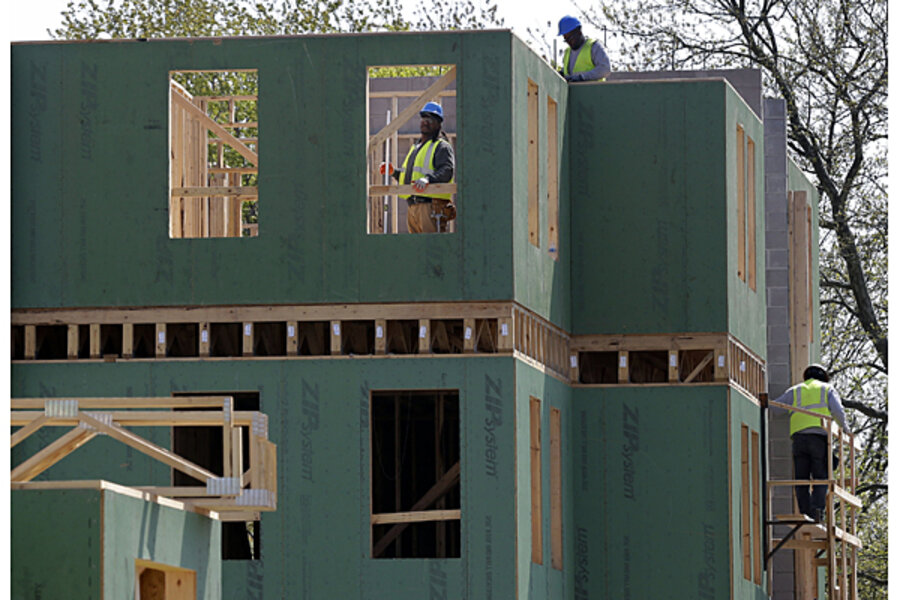New home sales rise, but market still a long way from ‘normal’
Loading...
We’ve been hearing consistently good news on the housing front for a solid year now. Prices are up, sales are accelerating, and new construction is coming along. But while this week brought another round of positive signs, the United States is still a long way from what can be considered a “normal” housing market.
Both new and existing home sales improved last month. New home sales increased 2.3 percent in April to a seasonally adjusted annual rate of 454,000 homes (March was also revised upward to a 444,000 rate), according to a joint release from the US Census Bureau and the Department of Housing and Urban Development. That’s a 29 percent increase from the level seen a year ago.
“Not only did we have the increase in April, about as expected, but we had upward revisions for prior months and an acceleration in new home buying even compared to last year,” David Berson, chief economist for insurer Nationwide, said in a phone interview. "The level of sales and pace is the best that we’ve seen since the middle of 2008, when the economy was just beginning to fall into the Great Recession.”
Existing sales, which are calculated in a separate survey from the National Association of Realtors, crept up 0.6 percent to a 4.97 million annualized rate (again, with a revision upward for March). “April's existing home sales is evidence of continuing momentum in the residential real estate market,” John Tashjian, principal owner of Centurion Real Estate Partners in New York,” wrote in an e-mailed analysis. “We have watched the market move swiftly into the recovery stage of a cycle and predict continued growth in sales followed by price appreciation, throughout 2013 and 2014.”
“On existing homes, demand is coming form investors who are taking distressed homes off the market and renting them,” Mr. Berson adds. “But that helps on the new home side, too.”
Prices have also accelerated, driven by tight inventories of existing homes and increased buyer demand. Another hopeful sign: the sales percentage of distressed homes continues to fall, down to 18 percent of sales in April.
But Berson warns that the market still has a long way to go. “These are numbers that historically aren’t huge,” he says. “Even if you look in the ‘90s, new home sales ran in a range of anywhere between 600,000 and a million. We’re only at about half of where we should be, and it’s going to take a while. We saw 1.2, 1.3 million during the housing boom, but that’s unsustainable. We need to get back to a pace of sales justified by the demographics, say, 900,000" annually.
Two things are going to make getting to that point a slow climb, according to experts. The first is inventory, which is tight for both new and existing homes. “Unsold new home inventory are pretty close to all-time lows, because builders are being cautious,” Berson says. In the case of existing homes, the inventory squeeze is having a marked effect on certain areas of the country.
“Tight inventory – especially in the West, where the median price was up 17.5 percent from a year earlier – is clearly playing a role,” IHS Global Insight economists Patrick Newport and Stephanie Karol wrote in their e-mailed analysis. "Since housing starts are currently running well below underlying demand (1.3 to 1.5 million, according to our estimates), and since it takes on average about seven months to complete a home on getting a permit, inventories will probably remain lean through next year.”
The other culprit, at least according to the real estate industry, is stricter lending standards, which make it more difficult to get approved for a home loan. “We don’t want to go back to 2003, but it’s probably a little too tight today,” Berson says.
This housing recovery is different than others, he adds, in that in the past the generally reliable real estate market has been the sector that leads the economy out of recessions. This time, it was the area of the economy that was “hurt most by the recession and recovered relatively modestly this time.
Still, “the housing market will continue to improve and outperform the rest of the economy over the next few quarters,” Mr. Newport and Ms. Karol from IHS write. “Existing home sales should climb about 8.5 percent in 2013 and 12 percent in 2014.”






